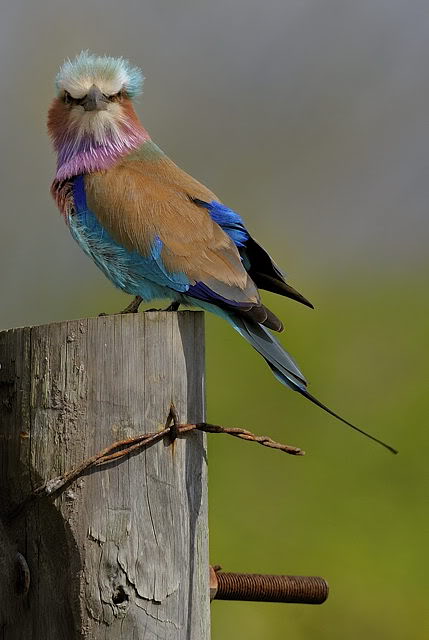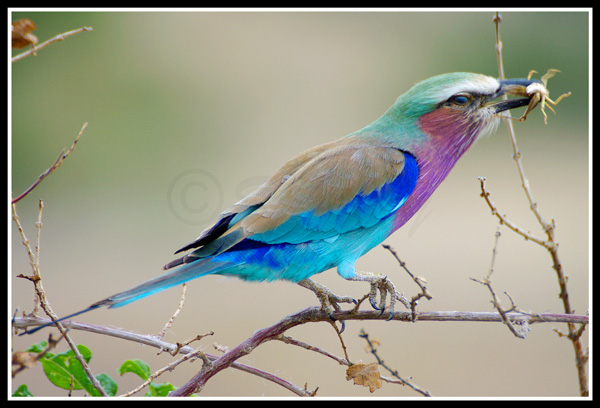Page 1 of 7
Rollers - Bird of the Month: December 2012
Posted: Sun Dec 02, 2012 1:38 pm
by Dewi
Please post all your photos of Roller species here and any information that's relavent to this family of birds.
Re: Rollers - Africa Wild Bird of the Month: December 2012
Posted: Sun Dec 02, 2012 2:02 pm
by Toko
Family: Coraciidae (Rollers)
The rollers are an Old World family, Coraciidae, of near passerine birds. The group gets its name from the aerial acrobatics some of these birds perform during courtship or territorial flights. Rollers resemble crows in size and build, and share the colourful appearance of kingfishers and bee-eaters, blues and pinkish or cinnamon browns predominating. The two inner front toes are connected, but not the outer one.
They are mainly insect eaters, with Eurystomus species taking their prey on the wing, and those of the genus Coracias diving from a perch to catch food items from on the ground, like giant shrikes.
They are monogamous and nest in an unlined hole in a tree or in masonry, and lay 2–4 eggs in the tropics, 3–6 at higher latitudes. The eggs, which are white, hatch after 17–20 days, and the young remain in the nest for approximately another 30 days.
The roller family Coraciidae is one of nine in the order Coraciiformes, which also includes the motmots, bee-eaters, todies, ground-rollers, Cuckoo Roller and three families of kingfishers. Apart from the ground-rollers, these families do not appear to be particularly closely related to the rollers, and the Coraciiformes are therefore probably polyphyletic. The division of the rollers into two genera is uncontroversial.
The eleven species are:
Genus: Coracias
European Roller Coracias garrulus
Abyssinian Roller Coracias abyssinicus
Lilac-breasted Roller Coracias caudatus
Racket-tailed Roller Coracias spatulatus
Rufous-crowned Roller Coracias naevius
Indian Roller Coracias benghalensis
Purple-winged Roller Coracias temminckii
Blue-bellied Roller Coracias cyanogaster
Genus: Eurystomus
Broad-billed Roller Eurystomus glaucurus
Blue-throated Roller Eurystomus gularis
Azure Dollarbird Eurystomus azureus
Oriental Dollarbird Eurystomus orientalis
The Coraciiformes family gets its scientific name for Latin coracium, "like a raven", and the English name "roller" from the aerial acrobatics some of these birds perform during courtship or territorial flights.
Morphology and appearance
Rollers resemble crows in size and build, ranging from 25 to 27 cm (10–11 in) in length. They share the colourful appearance of kingfishers and bee-eaters, blues and pinkish or cinnamon browns predominating. The rollers are similar in general morphology to their relatives in the order Coraciiformes, having large heads on short necks, bright plumage, weak feet and short legs. The two inner front toes are connected, but not the outer one. The weakness of the feet and legs is reflected in their behaviour, rollers do not hop or move along perches and seldom use their feet other than for occasional lurching leaps along the ground pursuing escaping prey. The bill is robust, and is shorter yet broader in the genus Eurystomus, sometimes known as the broad-billed rollers. The broad-billed rollers have brightly coloured bills, whereas those of the Coracias (or true) rollers are black. Other differences between the two genera are in wing length; the more aerial Eurystomus rollers have longer wings (and shorter feet still) than the Coracias rollers, this reflects differences in their foraging ecology. Their calls are repeated short, gruff caws.
Distribution and habitat
The rollers are found in warmer parts of the Old World. Africa has most species, and is believed to be where the family originated. This is supported by the fact that the related ground-rollers are found on Madagascar. The European Roller is completely migratory, breeding in Europe and wintering in Africa, and the Dollarbird also leaves much of its breeding range in winter. Other species are sedentary or short-range migrants.
These are birds of open habitats with trees or other elevated perches from which to hunt.
Breeding
Rollers are noisy and aggressive when defending their nesting territories, which they patrol while displaying their striking plumage. Intruders are attacked with intimidating rolling dives. They are monogamous and nest in an unlined hole in a tree or in masonry, and lay 2–4 eggs in the tropics, 3–6 at higher latitudes. The eggs, which are white, hatch after 17–20 days, and the young remain in the nest for approximately another 30 days. Egg laying is staggered at one-day intervals so that if food is short only the older larger nestlings get fed. The chicks are naked, blind and helpless when they hatch.
Feeding
Coracias rollers are watch-and wait hunters. they sit in a tree or on a post before descending on their prey and carrying it back to a perch in the beak before dismembering it. They take a wide range of terrestrial invertebrates, and small vertebrates such as frogs, lizards rodents and young birds. They will take items avoided by many other birds, such as hairy caterpillars, insects with warning colouration and snakes.
Eurystomus rollers hunt on the wings, swooping on flying beetles, crickets and other insects which are crushed by their broad deep beaks and eaten on the wing. The Azure Roller and Dollarbird will hunt huge swarms of termites and flying ants which appear after thunderstorms. Tens or hundreds of these rollers may be attracted to large swarms.
Species indigenous to southern Africa
Lilac-breasted roller Coracias caudatus
The Lilac-breasted roller is found from Eritrea and Somalia south to the northern half of southern Africa, where it is common in dry woodland. It feeds on a wide variety of animals, preferring insects over reptiles, arachnids, birds and rodents. It usually uses cavities in trees as nest sites, 2-8 m above ground, although it is capable of kicking other birds out of their nests. It lays 2-4 eggs, which are incubated by both sexes, for 17-25 days. The chicks stay in the nest for about 19 days, after which it is dependent on its parents for about 20 more days.
European roller Coracias garrulus
The European roller a non-breeding visitor, with breeding grounds in Morocco, Spain, Poland, Siberia and India, with its non-breeding range entirely in sub-Saharan Africa. In southern Africa, it has a scattered distribution range, preferring savanna, such as broad-leaved and Acacia woodland. It eats mainly flying insects, such as termite alates, beetles, and locusts, rarely eating small vertebrates. It hunts from perches, waiting until prey gets close, before pouncing on it.
Purple roller Coracias naevius
The Purple roller is endemic to Africa, being found from Senegal and Gambia to Somalia, extending south to southern Africa. It is widespread but uncommon, living in dry woodland and savanna. It feeds not only on insects but also scorpions, small reptiles, mice and even young birds. Courtship is elaborate, with courtship feeding and acrobatic flight displays commonly recorded. It lays 3-5 eggs, usually a cavity in a (frequently dead) tree, at least 5 m above ground. It also uses rock crevices and vertical pipes.
Racket-tailed roller Coracias spatulatus
The Racket-tailed roller is endemic to Africa, occupying an area from Tanzania to Angola, south to Zimbabwe Botswana and Mozambique. It prefers mature undisturbed deciduous woodland, especially Miombo, Mopane and Zambezi Teak woodland. Its diet is little known, but it is thought to feed mainly on insects, hunting from low perches, swooping to catch prey once spotted. It is probably a cooperative breeder, nesting in tree cavities about 6-7 m above ground, either natural or excavated by large woodpeckers. There is little more information about its breeding habits, as there have been no large studies done on this species.
Broad-billed roller Eurystomus glaucurus
The Broad-billed roller is found from Senegal east to Somalia, extending south to Zimbabwe, Mozambique, Botswana and north-eastern South Africa. Here it is fairly common in savanna, as well as clearings in woodlands. It is a specialist predator, mainly eating swarming termite and ant alates, as well as beetles and bugs. It mainly nests in unlined cavities in trees 5-15 m above ground. It also nests in holes of barns (recorded in Zimbabwe). It lays 2-4 eggs, timing laying to coincide with the emergence of insects after rain.
Re: Rollers - Africa Wild Bird of the Month: December 2012
Posted: Sun Dec 02, 2012 2:05 pm
by Toko
Lilac-breasted Roller Coracias caudata
Description
The Lilac-breasted Roller is a heavy billed, beautifully coloured bird with a green head, lilac throat and breast, a blue belly and even brighter blue wing feathers. Both sexes have the same colouration.
Distribution and habitat
The species is found throughout Eastern and Southern Africa, from Ethiopia south through Tanzania, southern DRC, Zambia and Angola to southern Africa. Within southern Africa it is common in Namibia (excluding the Namib Desert), Botswana, Zimbabwe, Mozambique and north-eastern South Africa. It generally prefers dry woodland, such as Acacia savanna, miombo woodland, palm savanna and mopane woodland. It often occupies the border between woodland and grassy clearings, using the former for breeding and the latter for foraging.
Food
It feeds on a wide variety of animals, especially insects, mainly hunting by sitting tight on a perch before pouncing on nearby prey. It preys on lizards and invertebrates but is also known to take small birds. The bird is often seen perched singly or in pairs on telephone wires and at the tops of trees, watching for their food of choice - mainly insects such as grasshoppers and large beetles, scorpions, snails and occasionally lizards.
Breeding
Monogamous solitary nester, vigorously defending its nest againts intruders, even outside the breeding season.
It usually uses cavities in trees as nest sites, 2-8 m above ground. It may also kick other birds out of their nests, such as Green wood-hoopoe or Cape Glossy starling. It also uses nest boxes and termite mounds as nests.
Egg-laying season is from August-February, peaking from September-December.
It lays 2-4 eggs, which are incubated by both sexes for 17-25 days.
The chicks stay in the nest for about 19 days, after which they are dependent on their parents for about 20 more days.
All rollers, including the lilac-breasted rollers, are highly territorial. They are also thought to be monogamous.
The rollers have a distinctive courtship flight, during which they dive from extreme height, rocking and rolling, while making loud, harsh calls.
Re: Rollers - Africa Wild Bird of the Month: December 2012
Posted: Sun Dec 02, 2012 2:05 pm
by Dewi
Re: Rollers - Africa Wild Bird of the Month: December 2012
Posted: Sun Dec 02, 2012 2:08 pm
by Sprocky
Re: Rollers - Africa Wild Bird of the Month: December 2012
Posted: Sun Dec 02, 2012 2:15 pm
by Sprocky
Re: Rollers - Africa Wild Bird of the Month: December 2012
Posted: Sun Dec 02, 2012 2:26 pm
by Sprocky
Re: Rollers - Africa Wild Bird of the Month: December 2012
Posted: Sun Dec 02, 2012 4:11 pm
by Amoli
Re: Rollers - Africa Wild Bird of the Month: December 2012
Posted: Sun Dec 02, 2012 4:15 pm
by Amoli
My matric go-away, chill-out holiday, was a few days to the park (but sleep in Nelspruit/Sabie -O -O )
The old-wives tale that went round at the time, was if you see a 'troupant' (LBR) while with a guy,
that's the guy you will marry....


... and it sure happened that way... -O -O
Re: Rollers - Africa Wild Bird of the Month: December 2012
Posted: Sun Dec 02, 2012 5:04 pm
by Flutterby











